Water, Gas and Electricity (not to mention sewage)
In consequence of the high price of candles, several inhabitants are lighting their dwellings with gas...
Western Times 21 January 1854 p7 col6
White's History, Gazetteer and Directory of Devon 1850 p 463
In 1842 the recently reconstructed works were advertised for letting by tender. According to the particulars, a 'moderate' amount of coal produced 'excellent' gas, and the by product of coke could be easily sold. The gas was used to light lamps in the town, which provided an income.
Exeter and Plymouth Gazette 28 May 1842 p2 col3
J Caunter chaired a meeting in September 1843, to decide the amount of money to be paid by the parish for Lighting the Town Lamps. Many of the yeoman objected to having any light at all.
Exeter and Plymouth Gazette 16 September 1843 p3 col4
In the late 1870s the Gas Works were leased to Mr I Brown, with manager Mr S Starr. There were 36 public lamps, and all the shops were supplied with gas, together with some private properties
White's History, Gazetteer & Directory of Devon, 1878-79 p105
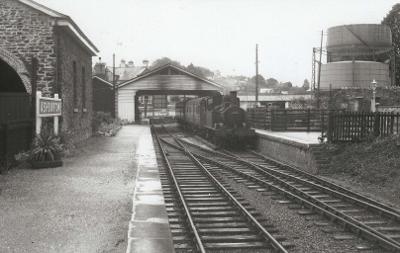
A meeting of shareholders in November 1899 decided to dissolve the company. The company had been incorporated under a Deed of Settlement, 1839
London Gazette Issue 27142 8 December 1899, p8267
In
1899 an enquiry was held by the Local Government Board into the
purchase of the Gas Works by Ashburton Urban District Council
Western Times 21 February 1899 p3 col3
Mr Walter Rook, of Havant, became manager of the Gas works
Western Times 3 July 1914 p14 col1
* ******* *
* Water *
Devonshire Characters and Strange Events, S Baring-Gould, London 1908 p478ff
In
1793 Sir Lawrence Palk and Sir Robert Mackreth, Members of Parliament
for Ashburton, had an aqueduct built in the town. This plaque, hard to
read and in Latin, commemorates its construction.
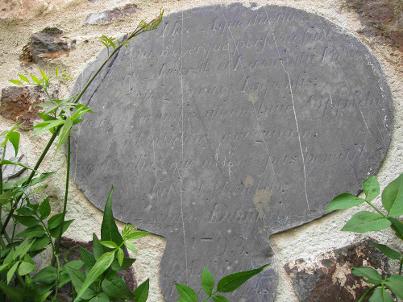
Above right: Plaque in a garden off West Street.
Many thanks to the owners (who wish to remain anonymous) for permission to photograph this item.
1854 John Sparke Amery, 'always interested in any public good', offered residents the use of spring water from any of his fields. Water was, said the Western Times, 'now so much wanted'.
Western Times 2 September 1854 p7 col6
In August 1855 there was a shortage of water in the East Street Conduit, resulting in its being turned off at night. Shares had been issued in a company proposing to the improve the water supply, but nothing had come of it.
Western Times 25 August 1855 p7 col5
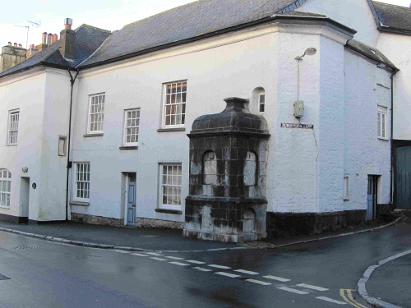
In the dry summer of 1870 'Jardine's Water Works' proved invaluable, but the Western Times complained of waste. The newspaper said that Mr Jardine had certainly never intended that the water be used for activities such as watering gardens, or used in industries such as brewing, or the Gas Works.
Western Times 30 September 1870 p8 col3
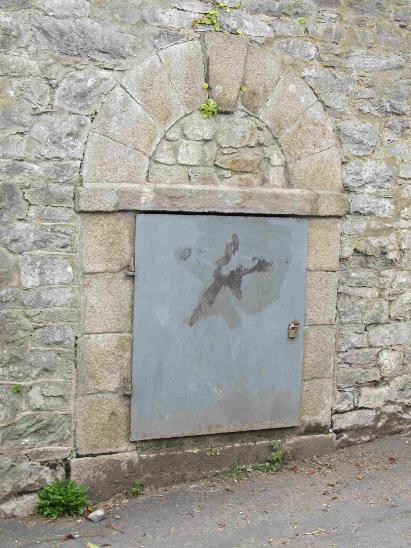
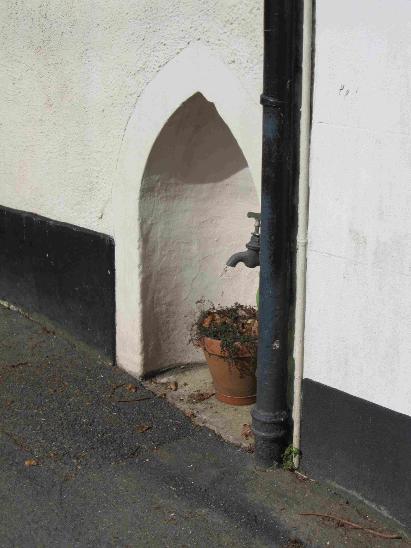
In May 1855 there was a proposal for a sewer in East Street. Many people believed that a sewer was unnecessary, and thought a good supply of water was more of a priority.
Western Times 12 May 1855 p7 col1
In 1856 the Western Times was able to report that sewers were about to be installed in East Street and North Street. The paper suggested that the next improvement must be to have a better water supply.
Western Times 12 July 1856 p7 col3
In 1869 the same newspaper was able to report that in spite of extraordinary weather conditions the streets of Ashburton had no surplus water, thanks to the complete sewer system.
Western Times 5 February 1869, p8 col3
'The effect of the sewage of Ashburton, Devon, as described by H Caunter Esq. - "As an illustration of the extraordinary effects of sewage water, even in a highly diluted state, I will mention the beautiful valley in Devonshire immediately below the little town of Ashburton. The stream of water which runs through the place receives all its sewage and the wash of two or three manufacturies, and is afterwards by a well arranged system made to irrigate the valley below for nearly three miles in extent, until it falls into the river Dart. The produce of this valley is perfectly astounding, and no stranger can ever pass along the high road from Ashburton to Buckfastleigh without being at once struck with the luxuriance and abundance of the pasture around him. The average rental is about £6 per acre." '*
Climate of England, George Shepherd, London, 1861, p44
When Pridhamsleigh, a dairy and stock farm, was up for let in 1919, it was advertised as having meadows of 'the highest quality, being watered with the sewage of Ashburton...'
Western Times 23 May 1919, p5 col4
* 'Even in the 1950s tomatoes grew beautifully along by the railway tracks.' Ashburton resident.